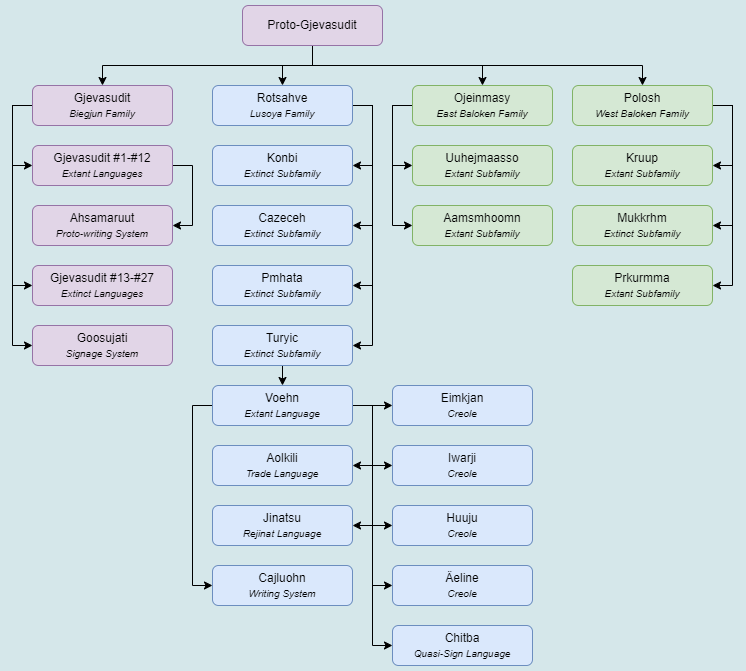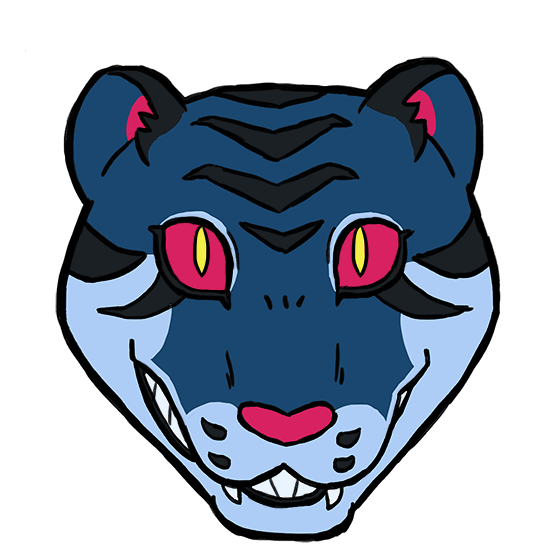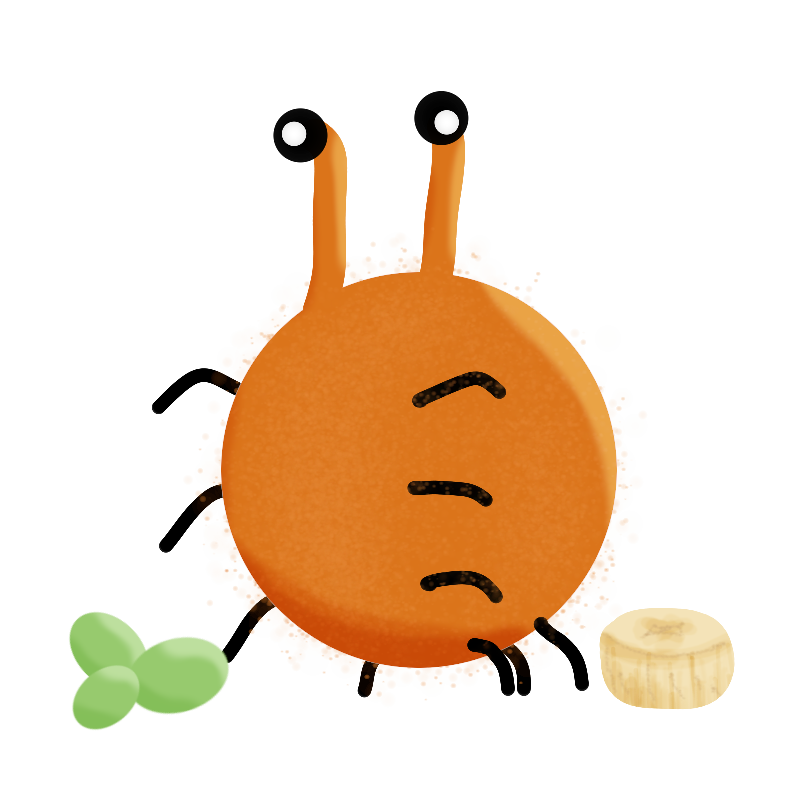Simplified Cladogram
Gjevasudit
The only family of languages that could be directly linked with Proto-Gjevasudit and its preceding extinct Human languages. Gjevasudit is currently categorized as a group of 12 extant languages, and another speculated 14 extinct languages.
Each of the extant languages contain anything from two to fourteen dialects, and there appear to be at least some level of mutual intelligibly between all of them.
Goosujati
As far as is known, the Bieggjan have relied entirely on oral tradition until quite recently. The only found instance of any form of writing system before that is the universally used signage system Goosujati. Its inventory of glyphs, their shapes, and their meanings appear to be identical for all tribes, and it's changed very little across the ages.
Ojeinmasy & Polosh
Baloken is thought to have been populated by sapients circa 1.2 to 1.3 million years ago. So far, archeological remains point two distinct population groups existing independently during this period, from which the
Baluke species trace their origins.
The
Ojeinen appeared in the northern, boreal regions of the planet’s largest continent,
Utoompa, and started as tribal nomads similarly to their Bieggjan ancestors. The
Polochci originate from somewhere in the massive oceanic archipelago of
Krop Hutvu and are thought to have early on founded a settled civilization focused on agriculture and fishing.
The two population groups developed in relative isolation and gave rise to several civilizations each, until the arrival of the Ascendancy.
Descendants of the Ojeinen and Polochci meet the criteria to be identified as separate subspecies of the Bieggjan but chose to be collectively identified as ‘Baluke’ both as a species and as a people.— Notation by Dr. Tybulus Svilen
The languages that developed on Utoompa are categorized as descendants of Ojeinmasy, also called the East Baloken Family, which further divide into the north-east continental
Uuhejmaasso and south-west continental
Aamshmoomn. The two subfamilies are estimated to contain 125-150 distinct extant languages each.
The languages that developed on Krop Hutvu are categorized as descendants of Polosh, also called the West Baloken Family, which further divide into the
Mukkrhm,
Kruup, and
Prkumma subfamilies. Mukkrhm and its descendants are all thought to be extinct today, but the other two are estimated to contain 65-80 distinct extant languages each.
Rotsahve
Lusoya are thought to have been populated by sapients around the same time period as Baloken, circa 1.2 and 1.3 million years ago, with the earliest traces of civilization being found in the
Roturuh basin. The original population are thought to have spoken a language, with or without dialectal differences, called Rotsahve. It developed into numerous languages with both dialectal and accentual variation as the
Lusoyan began to spread into new caverns and formed isolated to semi-isolated societies.
The languages descended from it are typically grouped into four major subfamilies, based on a combination of historically traced evolution and regional similarity:
Konbi,
Cazeceh,
Pmhata, and
Turyic. When globalization increased in later eras, the Turyic-descendent
Apvaturji and Konbi-descendent
Ehrebvha became prevalent to use as second languages and were eventually classified as lingua franca.
All of the languages of these four families were systematically made extinct after the Ascendancy introduced Voehn as not only its state language but its only accepted language.
Chitba
Classified as a quasi-sign language, Chitba is thought to be an intercultural adaptation by the non-lusoyan
Cheitosnu to safely communicate without breaking any of the Ascendancy's extremely strict legislations surrounding language use. Use of Chitba has seen a steady decline since these laws, specifically 'misuse of state language' and 'illegal use of non-sanctioned languages', were abolished less than 100 years ago.
Aolkili
The Ascendancy's choice to legislate a taboo against the learning and usage of any language but Voehn became an increasing liability in the modern era, severely hampering diplomatic work, trade and other instances where communication with foreign bodies were required. The compromise that was eventually decided on was to create the Voehn-derived, dedicated trade language Aolkili.
While it was conceptually sound, with a range of phonemes ensured to be producible by the majority of Rosepetal's sapients and significantly simplified syntax, it's yet to gain a lot of traction and has been met with a lot of criticism - even from their own people.
The largest criticism against Aolkili is the fact it forces both Ascendancy citizens and foreigners to learn an entirely new language. Rather than take advantage of the lusoyan's exceptional memorization ability and make an exception for certain professions to learn already established lingua francas.— Notation by Dr. Tybulus Svilen
Jinatsu
The
Rejinat created Jinatsu as a part of establishing their own society and cultural identity, likely shortly following the
Silent Revolt on
Rejin – An event where most of the Rejinat population unexpectedly and nearly unisonely abandoned their place as a labor force by vanishing into the ocean depths. They surfaced several decades later, during the rebellion instigated by the
Three Tails, with demands of independency as a species and people, and a claim for gaining governance over Rejin as their homeworld.
While Jinatsu and its dialects still aren’t officially recognized by the Ascendancy, it’s in all regards a fully-fledged, isolate language derived from Voehn. Jinatsu is considered the native language of the Rejinat and is taught alongside Aolkili at their educational institutions.
Cheitosnu Creoles
During the Ascendancy’s expansionist era, the populace of conquered alien civilizations became integrated into the Ascendancy as
Cheitosnu. Most were involuntarily uprooted from their original homes and designated to ghettos located at the outskirt of major lusoyan settlements. Each ghetto, barring the occasional forced displacement in order to manage over/underpopulation, became largely isolated from each other.
Over time, creolization gave rise to numerous ethnicities within these ghettos, most of mixed species and culture, though exceptions like the
Katari exist. Many of the ethnicities also developed their own creole languages, typically initially as pidgins that later became hybrids between Voehn and one or more of the following languages:
Cufosni,
Hifna,
Luy-Qianakun,
Mauwulen,
Snösmy,
Ueldish, and
Waomsuqes.
The creoles Eimkjan, Iwarji, Huuju and Äeline are the most well-known, as they’ve remained largely unchanged and even spread to become major languages after their speakers were returned to and given back governance of their ancestral homeworlds.










This is really impressive work!
Thank you!